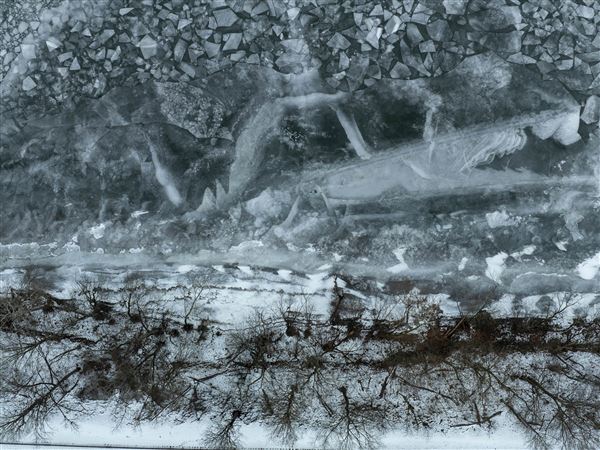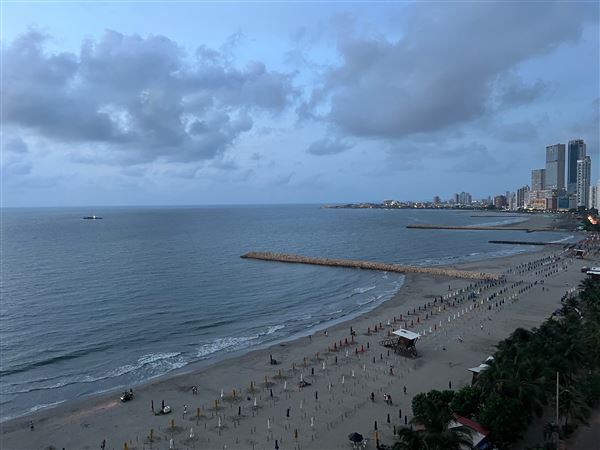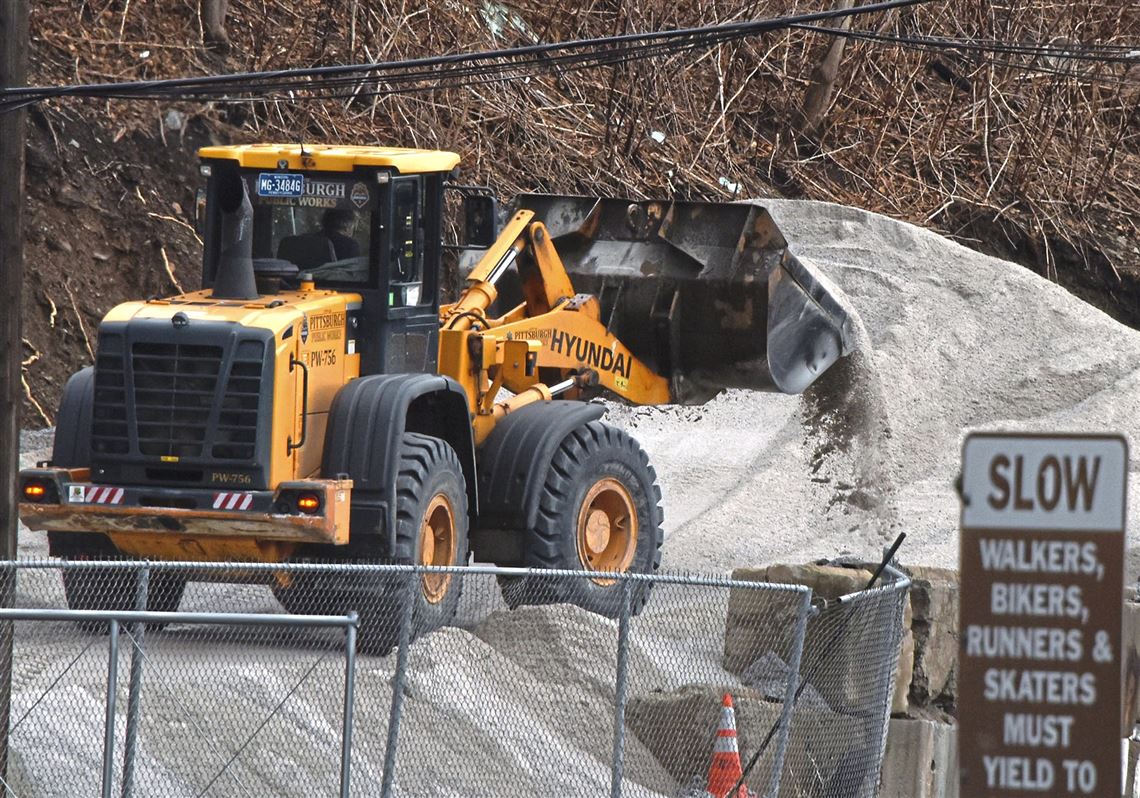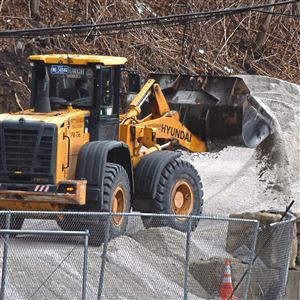Rock salt spread on roads and sidewalks helps Pittsburghers get around in the winter, but a new study shows sodium chloride’s use to melt snow and ice also has a big, long-term and wide-ranging ecological downside.
Freshwater rivers, streams and estuaries across North America are becoming saltier and more alkaline, a mixed but mostly unwelcome turn caused by runoff from road and sidewalk salt spreading, agricultural and lawn fertilizers, and other man-made chemical releases, according to the study published Monday in the Proceedings of the National Academy of Sciences.
“Many people assume that when you apply salt to the landscape it just gets washed away and disappears. But salt accumulates in soils and groundwater and takes decades to get flushed out,” said Sujay Kaushal, professor of geology at the university of Maryland and the study’s lead author.
The peer-reviewed study, which analyzed five decades of data from 232 U.S. Geological Survey river and stream monitoring sites, is the first to assess the extended changes in freshwater salinity and alkalinity across the continent and found significant increases in both.
Salinity is higher in 37 percent of the drainage area of the contiguous U.S., the study found, and alkalinity is up in 90 percent.
The study is also the first to identify multiple salt contaminants in surface waters and suggest that they are driving up the pH, or alkalinity, of water as well.
“Until now, we didn’t fully appreciate the role that different salts play in altering the pH of streams and rivers of our country,” said study co-author Gene Likens, a University of Connecticut professor and president emeritus of the Cary Institute of Ecosystem Studies. “Salt content and pH are fundamental aspects of water chemistry, so these are major changes to the properties of freshwater.”
Significant changes were documented in many of the nation’s major rivers and river systems, including the Hudson, Potomac, Canadian , Chattahoochee and Mississippi.
None of the USGS monitoring sites used by the researchers are in the Allegheny, Monongahela or upper Ohio river watersheds, but the region’s rivers and streams are likely in the same boat as other eastern watersheds, said Ryan Utz, an assistant professor of water resources at Chatham University’s Falk School of Sustainability & Environment and a study co-author.
“The East, this is where all the humans are, where people are fertilizing their lawns, where there’s a lot of roads,” Mr. Utz said. “In the watersheds around Pittsburgh there are also a ton of humans and roads, and I’d expect the same impacts on the water.”
Those surface water quality changes, what the study terms the “Freshwater Salinization Syndrome,” have occurred most prominently in densely populated watersheds in the eastern and midwestern U.S. where salinity and alkalinity have increased most rapidly.
Mr. Utz said there are pluses and minuses to the chemical changes in American waterways. The more alkaline waterways make it easier for freshwater mussels and clams to build their shells, and may buffer more acidic ocean water in estuary areas like the Delaware and Chesapeake bays, he said. But the higher alkalinity could also increase scaling in municipal water systems and can make it more difficult for utilities and industries to use the water for cooling purposes.
“This is a continental-scale problem,” Mr. Utz said. “And there’s not too much that the average person can do about it. At this stage, we really don’t know what the single biggest culprit is.”
The causes of the saltier water vary from region to region, Mr. Kaushal said.
In the East, New England and Mid-Atlantic regions where snow occurs, road salt has an impact on salinity in rivers and streams. During atypical winter, road crews across the U.S. spread more than 20 million tons of rock salt, which lowers the freezing temperature of water, thus melting snow and ice.
Waterway contamination from road salt is particularly bad in urban areas, and because it’s transported more easily than sodium, chloride is the greater concern, according to the USGS. An estimated 40 percent of the nation’s urban streams have chloride levels that endanger their aquatic life, largely because of road salt.
Fertilizers, especially those containing high amounts of potassium, are a problem in the agricultural Midwest. In other regions, mining waste, sewage, irrigation runoff, weathering of concrete, rock and soils, and brines from shale gas drilling can boost salinity of adjacent waterways.
A number of initiatives are already underway to reduce runoff into streams and rivers from deicers and fertilizers.
Mr. Kaushal said fertilizer can be applied in reduced amounts and outside of rainy seasons when they are more likely to be washed away. He said choosing the right salt compounds for specific temperatures and conditions can minimize salt runoff, as can the application of controlled amounts of salt brines instead of solid salts
Rich Kirkpatrick, a Pennsylvania Department of Transportation spokesman, said Pennsylvania and other states that use salt as a deicer are already aware of the impact of road salt on the environment and research on improving salt use is underway.
“PennDOT works to find a balance between the optimum use of road salt and the safety of the motoring public,” Mr. Kirkpatrick said. “We currently have a contract with Temple University for additional research into the environmental impact of a number of deicing materials. We expect a final report later this year.”
The $90,000 stud, paid for by a Federal Highway Administration grant, began in 2015 and has involved road testing of a variety of deicing salts and materials.
Mr. Kirkpatrick also said new technologies that allow PennDOT to track salt spreading and usage by individual snow plows and trucks, its roadside sensing equipment and ongoing research on new salt products and application techniques, have allowed the department to use road salt “as efficiently and effectively as we can and still maintain safe, passable roads.”
The waterways study was supported by the National Science Foundation, the U.S. Geological Survey, the Hudson River Foundation, the Chesapeake Bay Program and the Maryland Department of Natural Resources.
A link to the study abstract is at: http://www.pnas.org/content/early/2018/01/03/1711234115.abstract
Don Hopey: dhopey@post-gazette.com, 412-263-1983, or on Twitter @donhopey
First Published: January 14, 2018, 5:00 a.m.



















